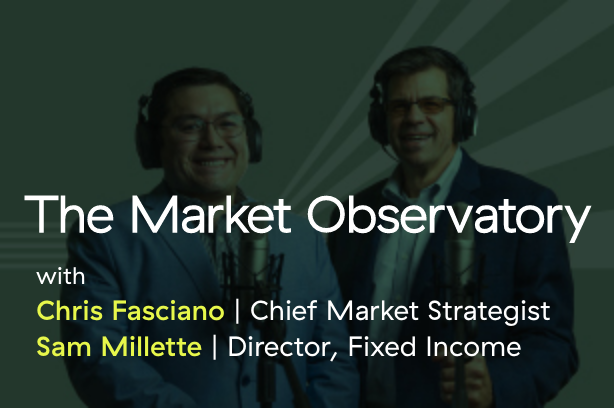My colleague Sam Millette, manager, fixed income on Commonwealth’s Investment Management and Research team, helped me put together this month’s Economic Risk Factor Update. Thanks for the assist, Sam! Let’s take a closer look.
January 11, 2023
My colleague Sam Millette, manager, fixed income on Commonwealth’s Investment Management and Research team, helped me put together this month’s Economic Risk Factor Update. Thanks for the assist, Sam! Let’s take a closer look.
January 10, 2023
With the new Congress taking office—and specifically the extended time it took for the House Republicans to elect their new speaker—markets are increasingly focused on the potential effects of politics on the economy this year. I have had several questions about the debt ceiling in particular, so let’s take some time and think through what all of this might mean.
January 9, 2023
Each week, we break down the latest U.S. economic reports, including what the results mean for the overall health of the economy. Here, you will find how economists’ forecasts compare with actual results, key takeaways to consider, as well as a list of what’s on tap for the week ahead.
December saw a sell-off, reversing some of the bounce from October and November and leaving markets up for the quarter. Unfortunately, that only reversed a small part of the damage done earlier in the year. 2022 closed as one of the worst years in recent memory for financial markets.
January 5, 2023
As we wait for tomorrow’s jobs report, there is a lot of angst in the air. One of the most predicted recessions in history is very likely to hit this year. The manufacturing business sentiment survey yesterday was down, seemingly confirming that outcome. The Fed is looking to substantially weaken the labor market, in search of lower inflation, and according to the meeting notes released yesterday, is going to keep raising rates until that happens. All of the signs are that the jobs market will weaken significantly. But the question remains, is the job market actually going to weaken?
January 4, 2023
December closed out a tough year for markets. The U.S. indices showed single-digit declines for the month, capping off drops for the year of about 7 percent for the Dow, more than 18 percent for the S&P 500, and 32 percent for the Nasdaq. The primary drivers were rising inflation and Fed rate increases. Still, job growth remained healthy, and consumer spending and business investment rose.
January 3, 2023
Each week, we break down the latest U.S. economic reports, including what the results mean for the overall health of the economy. Here, you will find how economists’ forecasts compare with actual results, key takeaways to consider, as well as a list of what’s on tap for the week ahead.
December 30, 2022
Earlier this week, I discussed what 2022 taught us about risk. Today, I want to talk about what I will be doing to manage risk in 2023, given those lessons.
December 28, 2022
For investors, 2022 has been a tough year. We had bear markets in both stocks, which is fairly common, and bonds, which is not common at all. They both happened at the same time, so rather than being saved by diversification, portfolios got hit twice. Even portfolios that were designed to weather market storms, such as a typical 60 percent stocks and 40 percent bond allocation, were hit harder than anyone expected. 2022 was an exceptional year and not in a good way.
December 28, 2022
Since March 2022, the Fed has continued to hike rates in an effort to control red-hot inflation. Equity and fixed income markets, both at home and abroad, struggled as a result, with markets down in the high double-digits year-to-date. But the tide may be changing.

Episode 13
November 19, 2025
Episode 12
October 14, 2025
Episode 11
September 10, 2025
Episode 10
August 13, 2025
Episode 9
July 23, 2025
The information on this website is intended for informational/educational purposes only and should not be construed as investment advice, a solicitation, or a recommendation to buy or sell any security or investment product. Please contact your financial professional for more information specific to your situation.
Certain sections of this commentary contain forward-looking statements that are based on our reasonable expectations, estimates, projections, and assumptions. Forward-looking statements are not guarantees of future performance and involve certain risks and uncertainties, which are difficult to predict. Past performance is not indicative of future results. Diversification does not assure a profit or protect against loss in declining markets.
The S&P 500 Index is a broad-based measurement of changes in stock market conditions based on the average performance of 500 widely held common stocks. All indices are unmanaged and investors cannot invest directly in an index.
The MSCI EAFE (Europe, Australia, Far East) Index is a free float‐adjusted market capitalization index that is designed to measure the equity market performance of developed markets, excluding the U.S. and Canada. The MSCI EAFE Index consists of 21 developed market country indices.
One basis point (bp) is equal to 1/100th of 1 percent, or 0.01 percent.
The VIX (CBOE Volatility Index) measures the market’s expectation of 30-day volatility across a wide range of S&P 500 options.
The forward price-to-earnings (P/E) ratio divides the current share price of the index by its estimated future earnings.
Third-party links are provided to you as a courtesy. We make no representation as to the completeness or accuracy of information provided on these websites. Information on such sites, including third-party links contained within, should not be construed as an endorsement or adoption by Commonwealth of any kind. You should consult with a financial advisor regarding your specific situation.
Member FINRA, SIPC
Please review our Terms of Use.
Commonwealth Financial Network®